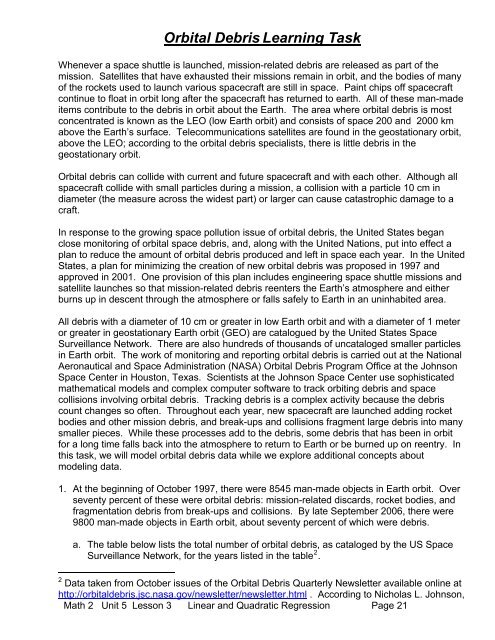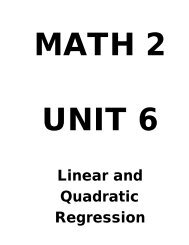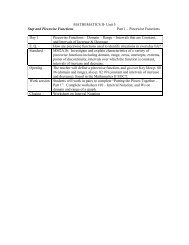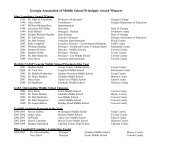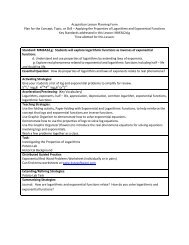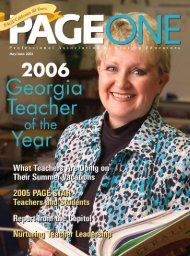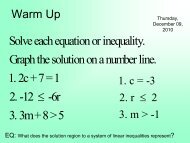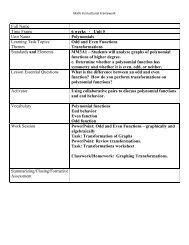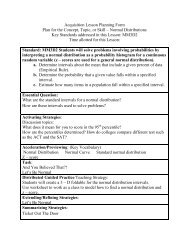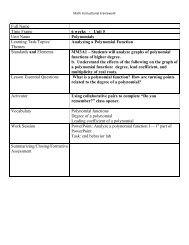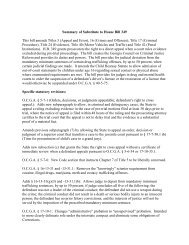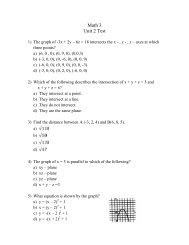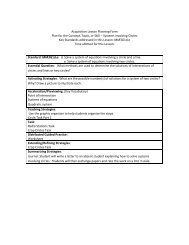Acquisition Lesson Planning Form - Ciclt.net
Acquisition Lesson Planning Form - Ciclt.net
Acquisition Lesson Planning Form - Ciclt.net
- No tags were found...
Create successful ePaper yourself
Turn your PDF publications into a flip-book with our unique Google optimized e-Paper software.
Orbital Debris Learning TaskWhenever a space shuttle is launched, mission-related debris are released as part of themission. Satellites that have exhausted their missions remain in orbit, and the bodies of manyof the rockets used to launch various spacecraft are still in space. Paint chips off spacecraftcontinue to float in orbit long after the spacecraft has returned to earth. All of these man-madeitems contribute to the debris in orbit about the Earth. The area where orbital debris is mostconcentrated is known as the LEO (low Earth orbit) and consists of space 200 and 2000 kmabove the Earth’s surface. Telecommunications satellites are found in the geostationary orbit,above the LEO; according to the orbital debris specialists, there is little debris in thegeostationary orbit.Orbital debris can collide with current and future spacecraft and with each other. Although allspacecraft collide with small particles during a mission, a collision with a particle 10 cm indiameter (the measure across the widest part) or larger can cause catastrophic damage to acraft.In response to the growing space pollution issue of orbital debris, the United States beganclose monitoring of orbital space debris, and, along with the United Nations, put into effect aplan to reduce the amount of orbital debris produced and left in space each year. In the UnitedStates, a plan for minimizing the creation of new orbital debris was proposed in 1997 andapproved in 2001. One provision of this plan includes engineering space shuttle missions andsatellite launches so that mission-related debris reenters the Earth’s atmosphere and eitherburns up in descent through the atmosphere or falls safely to Earth in an uninhabited area.All debris with a diameter of 10 cm or greater in low Earth orbit and with a diameter of 1 meteror greater in geostationary Earth orbit (GEO) are catalogued by the United States SpaceSurveillance Network. There are also hundreds of thousands of uncataloged smaller particlesin Earth orbit. The work of monitoring and reporting orbital debris is carried out at the NationalAeronautical and Space Administration (NASA) Orbital Debris Program Office at the JohnsonSpace Center in Houston, Texas. Scientists at the Johnson Space Center use sophisticatedmathematical models and complex computer software to track orbiting debris and spacecollisions involving orbital debris. Tracking debris is a complex activity because the debriscount changes so often. Throughout each year, new spacecraft are launched adding rocketbodies and other mission debris, and break-ups and collisions fragment large debris into manysmaller pieces. While these processes add to the debris, some debris that has been in orbitfor a long time falls back into the atmosphere to return to Earth or be burned up on reentry. Inthis task, we will model orbital debris data while we explore additional concepts aboutmodeling data.1. At the beginning of October 1997, there were 8545 man-made objects in Earth orbit. Overseventy percent of these were orbital debris: mission-related discards, rocket bodies, andfragmentation debris from break-ups and collisions. By late September 2006, there were9800 man-made objects in Earth orbit, about seventy percent of which were debris.a. The table below lists the total number of orbital debris, as cataloged by the US SpaceSurveillance Network, for the years listed in the table 2 .2 Data taken from October issues of the Orbital Debris Quarterly Newsletter available online athttp://orbitaldebris.jsc.nasa.gov/newsletter/newsletter.html . According to Nicholas L. Johnson,Math 2 Unit 5 <strong>Lesson</strong> 3 Linear and Quadratic Regression Page 21


